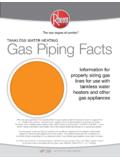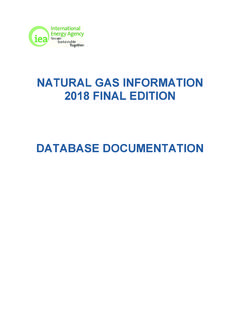Transcription of Journal of Natural Gas Science and Engineering
1 Performance analysis of liquefied Natural gas storage tanks inrefueling stationsAmir Sharafian, Omar E. Herrera, Walter M erida*Clean Energy Research Centre, The University of British Columbia, 2360 East Mall, Vancouver, BC, V6T 1Z3, Canadaarticle infoArticle history:Received 5 August 2016 Received in revised form28 September 2016 Accepted 26 October 2016 Available online 28 October 2016 Keywords:Liquefied Natural gasBoil-off gasStorage tankHolding timeRefueling stationabstractLiquefied Natural gas (LNG) could replace diesel in the transportation sector. However, fugitive emissionsincluding boil-off gas (BOG) across the LNG supply chain have revealed uncertainties on the overallenvironmental benefits of such replacement. In this study, time-dependent thermodynamic models weredeveloped to study the LNG holding time of storage tanks in refueling stations before BOG releases to theatmosphere.
2 Previously overlooked factors, such as the thermal mass of storage tanks and the actualoperating conditions at refueling stations, were included explicitly in the models. The effect of thethermal mass of storage tanks on holding time is illustrated by an analysis of m3storage tanksfilledwith LNG at 150 C and C. The tank with the lower temperaturefills shows longerholding time. Further investigations highlight the importance of the ratio of heat transfer surface area tothe LNG volume as a key factor in proper sizing of storage tanks to maximize the holding time. Finally,the modeling of a m3storage tank with a heat transfer coefficient of W/m2K shows that fueldelivery rates as low as m3/day are sufficient to maintain the tank pressure within allowable limits. 2016 Elsevier All rights IntroductionClimate change is one of the main concerns of today's world(Richter, 2014), but greenhouse gas (GHG) emissions from indus-trial and transportation processes have steadily increased (Globalgreenhouse, 2016; Sources of greenhouse gas emissions, 2016;Liimatainen et al.)
3 , 2014). For instance, the GHG emissions fromthe medium- and heavy-duty trucks increased by 76% between1990 and 2014 and reached Mt CO2,eq(Inventory of ,2016). According to the announcements at the 21st Conference ofParties in Paris, mitigation of climate change and reaching the 2 Cscenario targets would require immediate and significant changesover the next three decades (as opposed to changes occurring overcenturies) (21st session of the Conference of the Parties et al., 2015).It has been claimed that replacing conventional petroleum fuels, , diesel and gasoline, with low-carbon content fuels reducesGHG emissions and climate change (van Der Hoeven, 2015). Naturalgas (NG) is considered a low-carbon content fuel (Van Den Broeket al., 2015) and several studies reported the benefits of NG oneconomic and market growth (Van Den Broek et al., 2015; Imranet al.
4 , 2016; Hao et al., 2016; Wang and Li, 2016; Furuoka, 2016;Balitskiy et al., 2016; Wang et al., 2016; S evik, 2015; Wang andLin, 2014; Kakaee et al., 2014; Wang et al., 2014; Khan et al.,2015). However, and despite this significant body of work, recentstudies revealed uncertainty in the overall benefits associated withNG use (Alvarez et al., 2012; Howarth et al., 2011; Venkatesh et al.,2011; Davis and Shearer, 2014; McJeon et al., 2014; Delgado andMuncrief, 2015). According to the Global Warming Potential(GWP), methane emissions contribute up to 72 times more toclimate change than CO2in a 20-year horizon (Solomon, 2007).Therefore, the reduction in CO2emissions from NG use must becompared to the impact of the corresponding methane reliable data on the actual deployment technologies, mostof the models and analyses comparing widespread NG use to theexisting energy options will remain Natural gas (LNG) is the condensed form of Natural gaswith 60% volumetric energy density of diesel (Study on Natural gas,2014).
5 The combustion of LNG in comparison with ultra-low sulfurdiesel can reduce CO2, NOx, and particulate matter emissions by upto 20%, 90%, and 100%, respectively (International Gas Union, 2015).These features make LNG a candidate fuel in the transportationsector to reduce GHG emissions, especially for large, mobile ap-plications, such as heavy-duty trucks (Bassi, 2011; Nicotra, 2013),trains (Dunn and LeBlanc, 2014; Energy Carriers, 2014; Al Ali, 2015),*Corresponding M erida).Contents lists available atScienceDirectJournal of Natural Gas Science and Engineeringjournal 2016 Elsevier All rights of Natural Gas Science and Engineering 36 (2016) 496e509and ships ( s y et al., 2011; Seo et al., 2016). Nevertheless, fugitiveemissions from LNG are a major is a cryogenic liquid stored at temperatures as lowas 162 C. Due to its large temperature gradient with the envi-ronment, LNG is gradually heated and evaporates (boil-off gas(BOG)).
6 Methane (the major component in LNG mixtures) is apotent GHG and has more impact on climate change than CO2dueto methane higher radiative forcing (Solomon, 2007). The BOGleads to undesirable pressurization across the LNG distributionchain (Chen et al., 2004). In large LNG carriers, the BOG is re-liquefied or used as fuel to keep the LNG at atmospheric pressureand low temperature (Miana et al., 2015). In large LNG regasifica-tion plants and storage facilities, the BOG can be used to generateelectricity (Querol et al., 2010). However, in small-scale applica-tions, such as LNG refueling stations, the BOG management is morechallenging. BOG generation and methane emissions from LNGfacilities are originated from (Lowell et al., 2013): 1) heat transfer toLNG and pressurization of storage tanks, 2) ventilation of displacedBOG whenfilling a tank, 3) heat transfer to hoses, lines, and pumps,4) precooling of equipment prior to LNG transfer, and 5) LNGtransfer from a high pressure tank to a low pressure et al.
7 (2015). classified the Natural gas (NG) well-to-tank into four sectors to quantify fugitive emissions rate: 1) gasfield, 2) processing, 3) transmission and storage, and 4) distribu-tion. Their analysis showed that on average of NG wasemitted to the atmosphere across the value chain. Their in-vestigations also indicated that transportation and storage sectoraccounted for 35% of methane emissions followed by the distri-bution sector, which includes refueling stations and fueling process,with 28%. Therefore, the transportation, storage, and distributionsectors have significant opportunities to improve by preventing theBOG release andfixing existing leaks. The main focus of this study ison the distribution toBurnham et al. (2015), the average methaneventing from LNG refueling stations was about per delivery ofLNG. Hailer's measurements from two LNG refueling stations in indicated that one of the operating stations had methaneemissions of of fuel dispensed to vehicles (Hailer, 2015).
8 However, the second station had methane emissions of surveys from 2400 LNG refueling stations in China demon-strated that more than 1600 stations had daily methane emissionsof greater than 5% and in some cases 10% due to improper insu-lation (G boil off gas (G) em, 2015). China has currently about 3200 LNG refueling stations (development status, 2015) which accountfor 94% of the total refueling stations around the world (Sharafianet al., 2016). It is expected that the number of LNG refueling sta-tions in the and China will reach 223 and 5000 by 2020, appropriate thermodynamic models to determinethe weaknesses in the design of LNG infrastructures and quantifytheir BOG generation rates is thefirst step toward the design of zeroor near zero fugitive emissions LNG facilities. A summary of rele-vant thermodynamic studies on LNG infrastructures are listed inTable LNG facilities investigated inTable 1illustrate the recentwork on LNG storage tanks (Chen et al.)
9 , 2004; Barclay et al., 1998;Adom et al., 2010; Pellegrini et al., 2014; Liu et al., 2015; Miglioreet al., 2015), transportation (Hasan et al., 2009; Miana et al., 2010;Pellegrini et al., 2014), unloading (tank-to-tank transfer) (Yan andGu, 2010), regasification terminals (Querol et al., 2010; Park et al.,2012; Fahmy et al., 2015; Kurle et al., 2015), and LNG weathering(Miana et al., 2010; Pellegrini et al., 2014). There are limited studiesavailable in the literature on LNG storage tanks with less m3capacity for LNG refueling station applications, such asRefs. (Chen et al., 2004; Barclay et al., 1998; Pellegrini et al., 2014).These tanks can hold LNG at pressures about 1300 kPa which arehigher than those of large storage tanks (100,000e300,000 m3)used in tanker ships with operating pressures close to atmosphericpressure. The difference between these operating pressures affectsthe thermo-physical properties of LNG, LNG holding time, and theBOG generation rate.
10 LNG holding time refers to the time a storagetank can hold the LNG without venting (Delgado and Muncrief,2015).In this study, we analyze LNG storage tanks of refueling stationsby using practical parameters such as tank storage size, LNG initialtemperature, tank thermal insulation, and fuel delivery rate. Themain differences between this study and previous models in Refs(Chen et al., 2004; Barclay et al., 1998; Adom et al., 2010; Pellegriniet al., 2014). are to consider the thermal mass of storage tank anduse real operating temperatures and pressures for the LNG atrefueling stations. Previous studies used LNG at 162 C (the dewpoint of NG at atmospheric pressure) for the modeling which is notthe case in a LNG refueling station. This study highlights theimportance of these parameters on the model predictions, such asheat transfer rate to tank, LNG holding time, and the BOG genera-tion LNG refueling stations and vehicles' fuel supply systemLNG is dispensed to vehicles in two conditions: 1) Unsaturated(cold) LNG at a less than 143 C and 340 kPa, and 2) saturated(warm) LNG at 125 to 131 C, and 690e930 kPa (Roche, 2009).









